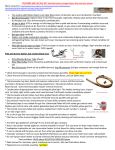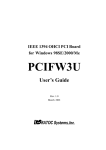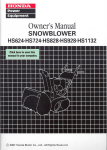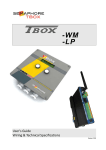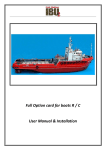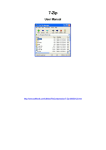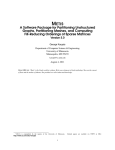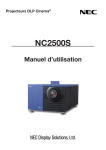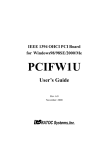Download Primera PX450 User`s manual
Transcript
511250.qxd 6/2/2009 6:43 PM Page i 060209-511250-(02) (Color Printer 450) User's Manual © 2009 All rights reserved 511250.qxd 6/2/2009 6:43 PM Page ii Notices: The information in this document is subject to change without notice. NO WARRANTY OF ANY KIND IS MADE WITH REGARD TO THIS MATERIAL, INCLUDING, BUT NOT LIMITED TO, THE IMPLIED WARRANTIES OF MERCHANTABILITY AND FITNESS FOR A PARTICULAR PURPOSE. No liability is assumed for errors contained herein or for incidental or consequential damages in connection with the furnishing, performance, or use of this material. This document contains proprietary information that is protected by copyright. All rights are reserved. No part of this document may be photocopied, reproduced, or translated into another language without prior written consent. Trademark Acknowledgments: Windows is a registered trademark of Microsoft Corporation. All other trademarks are the property of their respective owners. Printing History Edition 2.0, #060209, Copyright 2009, All rights reserved. FCC Compliance Statement: This device complies with part 15 of the FCC rules. Operation is subject to the following two conditions: (1) this device may not cause harmful interference, and (2) this device must accept any interference received, including interference that may cause undesired operation. For Users in the United States: This product is intended to be supplied by a UL listed Direct Plug-In Power Supply marked "Class 2"or a UL listed ITE Power Supply marked "LPS" with output rated 12VDC, 4.5A or higher. This equipment has been tested and found to comply with the limits for a Class A digital device, pursuant to Part 15 of the FCC Rules. In a domestic environment this product may cause radio interference, in which case the user may be required to take adequate measures. This equipment generates, uses, and can radiate radio frequency energy and, if not installed and used in accordance with the instructions, may cause harmful interference to radio communications. However, there is no guarantee that interference will not occur in a particular installation. If this equipment does cause harmful interference to radio or television reception, which can be determined by turning the equipment off and on, the user is encouraged to try to correct the interference by one or more of the following measures: • Re-orient or relocate the receiving antenna. • Increase the separation between the equipment and receiver. • Connect the equipment into an outlet on a circuit different from that to which the receiver is connected. • Consult the dealer or an experienced radio/TV technician for help. Use of shielded cables is required to comply with the Class A limits of Part 15 of the FCC Rules. You are cautioned that any changes or modifications not expressly approved in this manual could void your authority to operate and/or obtain warranty service for this equipment. For Users in Canada: This digital apparatus does not exceed the Class A limits for radio noise for digital apparatus set out on the Radio Interference Regulations of the Canadian Department of Communications. Le present appareil numerique n'emet pas de bruits radioelectriques depassant les limites applicables aux appareils numeriques de la class A prescrites dans le Reglement sur le brouillage radioelectrique edicte par le ministere des Communications du Canada. CAUTION! TO PREVENT FIRE OR SHOCK HAZARD, DO NOT EXPOSE THE UNIT TO RAIN OR MOISTURE. TO REDUCE THE RISK OF ELECTRIC SHOCK, DO NOT REMOVE EXTERIOR PANELS. NO USER-SERVICEABLE PARTS INSIDE. REFER SERVICING TO QUALIFIED SERVICE PERSONNEL. OPERATE THE UNIT WITH ONLY THE PROPER ELECTRICAL SPECIFICATIONS AS LABELED ON THE PRINTER AND AC ADAPTER. CAUTION! THIS PRODUCT CONTAINS A LASER DIODE OF A HIGHER CLASS THAN 1. TO ENSURE CONTINUED SAFETY, DO NOT REMOVE ANY COVERS OR ATTEMPT TO GAIN ACCESS TO THE INSIDE OF THIS PRODUCT. REFER ALL SERVICING TO QUALIFIED PERSONNEL. THE FOLLOWING LABEL APPEARS INSIDE YOUR UNIT: CLASS 1 LASER PRODUCT LASER KLASSE 1 CAUTION! USE OF CONTROLS OR ADJUSTMENTS OR PERFORMANCE OF PROCEDURES OTHER THAN THOSE SPECIFIED HEREIN MAY RESULT IN HAZARDOUS RADIATION. ii 511250.qxd 6/2/2009 6:43 PM Page iii Table of Contents Section 1: Getting Started ...............................................................................1 A. Choosing a Good Location ................................................................1 B. Unpacking and Inspection.................................................................2 C. Identifying the Parts ...........................................................................3 D. Computer Specifications ....................................................................4 Section 2: Hardware and Software Setup ...................................................5 A. Connecting Power...............................................................................5 B. Connecting the USB Cable/Installing the Printer Driver .................5 C. Installing Media ..................................................................................7 D. Installing the Ink Cartridge .............................................................10 E. Aligning the Ink Cartridge ..............................................................11 Section 3: Using the Integrated Cutter.......................................................12 Section 4: Printer Settings.............................................................................14 A. PC Printer Driver Settings ...............................................................14 Section 5: Advanced Configuration Settings............................................21 Section 6: Troubleshooting ...........................................................................25 A. Solving Registration Problems........................................................25 B. Clearing a Media Jam.......................................................................28 C. Cleaning the Printer..........................................................................28 D. Cleaning the Ink Cartridge..............................................................29 E. Technical Support..............................................................................29 Section 7: Media and Roll Specifications..................................................30 Section 8: Technical Specifications .............................................................32 Index..................................................................................................................33 iii Interactive.qxd 9/6/2005 3:30 PM Page 1 Interactive Feature in this PDF Document There are interactive features that will allow you to jump to different locations within the document. Each listing in the Table of Contents is interactive. Place the cursor on either the words or the page number. A small hand with a pointing finger icon appears. Click on the line with the icon and the document will jump to that page. If you want to return to the Table of Contents, move the icon to the top of the page and click on the arrow marked TOC. Navigating through the Index is similar. Place the icon on one of the listings or page numbers, click on it, and it will move to that page. The text relating to the Index listing will appear in red. Returning to the Index can be done by clicking on the arrow marked Index. 511250.qxd 6/2/2009 6:43 PM Page 1 INDEX TOC Section 1: Getting Started THANK YOU… ...for choosing an PX450 Color Point-of-Sale Printer. The PX450 Printer will print full color point of sale images quickly and reliably. This User's Manual is your complete step-by-step guide to quickly and easily setting up and printing with your new Printer! A. CHOOSING A GOOD LOCATION • • • • Place the printer on a flat surface in a location with adequate air circulation to prevent internal heat build-up. Do not place the printer near heat sources such as radiators or air ducts, or in a place subject to direct sunlight, excessive dust, mechanical vibration or shock. Allow for adequate clearance in front of the printer to accommodate the printed paper stock as it is leaving the printer to avoid the possibility of binding or jamming of the media. Allow for adequate overhead clearance for opening the top cover to allow easy access to the media and ink cartridge. Getting Started 1 511250.qxd 6/2/2009 6:43 PM Page 2 TOC INDEX B. UNPACKING AND INSPECTION While unpacking your printer, inspect the carton to ensure that no damage has occurred during shipping. Make sure that all supplied accessories are included with your unit. The following items should be included: • Printer • Power Adapter • Separate Power Cord • USB Cable • Software Installer CD • Color Ink Cartridge • Starter roll of continuous paper stock • Warranty Statement and Registration Card • This manual and other printed information Save the carton and packing materials. They will come in handy when transporting the printer. 2 Getting Started 511250.qxd 6/2/2009 6:43 PM Page 3 INDEX TOC C. IDENTIFYING THE PARTS This illustration shows the front of the printer with its control buttons and LED indicator lights. Media Sensor Bar Power LED Ink LED Top Cover Ink Button Cutter Load/Feed Button Unload Button The Power LED indicates that the printer is on and ready to receive print jobs. The Ink LED will illuminate when a cartridge has 10% or less of its ink remaining. The Ink Button moves the print carriage to the center of the printer so you can easily change the cartridge. The Load/Feed Button is pressed in order to load media or form feed the paper stock through the printer. The Unload Button will unload the installed media by reversing it through the printer. Make sure to tear off the printed media before pressing the Unload Button. Getting Started 3 511250.qxd 6/2/2009 6:43 PM Page 4 INDEX TOC This illustration shows the input ports and power switch found on the rear panel of the printer. Fan-fold Media Slot Power Switch USB Port Power Input Port D. COMPUTER SPECIFICATIONS Minimum PC Specifications For optimal printing speed you must have a PC with the following minimum specifications: • • • Pentium IV processor 512 MB of RAM 5 GB of free hard drive space 4 Getting Started 511250.qxd 6/2/2009 6:43 PM Page 5 INDEX TOC Section 2: Hardware and Software Setup A. CONNECTING POWER 1. Locate the Power Adapter supplied with your printer. 2. Plug the Power Adapter into the Power Input Port on the rear panel of the printer. 3. Plug the Power Cord of the adapter into an available wall outlet or surge protecting power strip. Once the Power Cord is connected, the printer can be switched on and off using the Power Switch. B. CONNECTING THE USB CABLE / INSTALLING THE PRINTER DRIVER 1. Place the installer CD in the computer's CD/DVD drive. Ignore any autorun/autoplay prompt that appears. 2. Connect the printer to your PC. 3. After a few moments, Windows™ will tell you it has found new hardware and is looking for software to install it. Hardware and Software Settings 5 511250.qxd 6/2/2009 6:43 PM Page 6 INDEX TOC 4. Select "Install the software automatically" and click Next. You may see a notice like the one shown here stating that the Printer has not passed Windows Logo Testing. Click Continue Anyway to continue installing the printer driver for your Printer. 6 Hardware and Software Settings 511250.qxd 6/2/2009 6:43 PM Page 7 INDEX TOC C. INSTALLING MEDIA Media Guide Your printer will utilize a wide variety of continuous media. Most inkjet receptive media within the provided size specifications will work in your printer. Primera carries a variety of media that has been converted and is ready for use with your printer. 1. Open the Top Cover. 2. Pull the spring-loaded Media Guide out far enough to fit the roll of media. Important Note: Using die-cut label stock is not recommended. 3. Remove any shipping tape from your media roll to ensure that it can unroll freely, making certain that no adhesive portion is exposed. It is important to note that any exposed adhesive surface can attach itself the inner workings of the print mechanism and cause a media jam. Roll Core Holders Hardware and Software Settings 7 511250.qxd 6/2/2009 6:44 PM Page 8 TOC INDEX 4. Place the media roll between the Roll Core Holders and release the spring-loaded Media Guide to hold the roll. The Roll Core Holders allow the roll to move freely. 5. Place the leading edge of the media between the Throat Guide and the side of the printer. Throat Guide 6. Feed the media further into the printer until it senses the media and automatically feeds it through the printer. If the printer fails to feed the media, press the Load/Feed Button on the front panel while continuing to guide the media into the printer. 8 Hardware and Software Settings 511250.qxd 6/2/2009 6:44 PM Page 9 INDEX TOC For narrow media it may be necessary to adjust the media sensor position. The scale on the Media Sensor Bar represents the distance from the sensor to the left edge of the media. Adjust the sensor to be roughly centered on the media. The media sensor is used to automatically detect when a label is fed into the printer and to stop the printer when the media is depleted. in. mm 0.5 12.7 1.0 25.4 1.5 38.1 2.0 50.8 Media Sensor Bar To adjust the sensor position, use a pen to move the slide bar to the correct postion. Hardware and Software Settings 9 511250.qxd 6/2/2009 6:44 PM Page 10 INDEX TOC D. INSTALLING THE INK CARTRIDGE Your printer has a built-in ink tracking system. This system is designed to warn you if your ink cartridge is low on ink. This ensures your labels will print properly. In order to make this system work properly, the Ink Cartridge must be changed using the procedure listed below. Failure to follow this procedure could result in inaccurate ink level tracking and could cause your print quality to suffer. When you encounter a low ink condition the Ink LED will flash and a low ink warning message will automatically print. The Ink Cartridge is changed as follows: 1. Open the Top Cover of the printer. 2. Press the Ink Button to move the Cartridge Holder to the center of the print area. 3. Press the Cartridge Cover Release to open the Cartridge Holder. 4. Remove the new Ink Cartridge from its packaging. Be sure to remove the protective tape covering the copper contacts. 5. Install the Ink Cartridge copper end first. 6. Push the Cartridge Cover downward until it snaps in place. 7. Press the Ink Button again. The Ink LED will turn off and the printer is now ready to print. 10 Hardware and Software Settings 511250.qxd 6/2/2009 6:44 PM Page 11 INDEX TOC E. ALIGNING THE INK CARTRIDGE Cartridge alignment is optional and is only necessary if you would like to improve print quality. Cartridge alignment will align the Color Ink Cartridge for bidirectional printing and calibrate the printer to each individual cartridge. Align the cartridge via the printer settings which are described in Section 4. For alignment you will need to have media installed that is equal to or larger than 3" (101.6mm) wide. If your stock does not meet this requirement follow the steps below: a. Unload your current stock by pressing the Unload Button. The printer will reverse the media so that it can be removed from the printer. b Now send the alignment via the printer preferences area. It is important that you send the alignment with no media installed. c. Cut a 8.5" x 11" sheet of paper in half lengthwise so that it is no wider than 4.25”. Push the paper into the feed area. Once the printer senses the page it will pull it into place. You must feed the test sheet of paper into the printer after the alignment print has been sent to the printer otherwise it will feed the sheet right through the printer without printing. d. The printer will print the alignment test and scan it into memory. Once the alignment is complete you will see a confirmation screen on your monitor. Click OK. Hardware and Software Settings 11 511250.qxd 6/2/2009 6:44 PM Page 12 TOC INDEX Section 3: Using the Integrated Cutter The printer has an integrated cutter that is designed to cut media on a continuous roll. By default the printer will automatically cut the media immediately after the image is printed. You can adjust when the cutter will cut and the cut position by accessing the settings in the Printer Preferences. WARNING: The cutter is not designed to cut through adhesive-backed media such as labels. While it will cut through most adhesive-backed media, continued use in this manner will cause premature wear on the cutter blade and excessive adhesive build-up. To Find Driver Settings: Click the Start button; choose Printers and Faxes. Right-click on the Color Label 450 icon and select Printing Preferences from the drop-down menu. Adjust the Following Settings: Output Mode: Do not Present. The media does not move after the last image is printed. This means that part of the last image printed is still in the printer. The media is not cut in this mode. Cut after No Activity. Use this setting to print multiple images/pages/documents consecutively and then cut after all have been printed. The time to wait before cutting can be adjusted using the Present Delay key in the configuration INI file. See Section 5. Cut Every Label (default setting). This mode presents and cuts the printed image after every print. Use for standard one-off printing. 12 Using the Integrated Cutter 511250.qxd 6/2/2009 6:44 PM Page 13 TOC INDEX Offsets - Cut Position: With this setting you can fine-tune the cut position after the image prints. Increase this value to move the media further out before the cut; decrease this value to eject the stock less before the cut. The unit of measure is is 0.1mm. Note: Every one-hundred cuts the cutter will cut twice (one cut, one cycle) to clean the blades. Note: If you are using Primera wristband stock the default Cut Position is set so that you do not cut through the adhesive portion of the the stock. If you adjust the Cut Position be make sure that it is not adjusted so that it cuts through the adhesive. Using the Integrated Cutter 13 511250.qxd 6/2/2009 6:44 PM Page 14 TOC INDEX Section 4: Printer Settings A. PC PRINTER DRIVER SETTINGS Refer to the following steps to change or verify your default printer driver preferences. To Find Driver Settings: Click the Start button; choose Printers and Faxes. Right-click on the Color Label 450 icon and select Printing Preferences from the drop-down menu. The preferences screen will appear. 14 Printer Settings 511250.qxd 6/2/2009 6:44 PM Page 15 INDEX TOC Paper Size This setting allows you to set the height and width of your print image in .01" or .1mm increments. Orientation There are two settings for orientation, Portrait and Landscape. If your text and graphics print left to right or as shown on the screen, select portrait . If you wish your printing to rotate 90 degrees from what you see on the screen so it is printing horizontally, select landscape as your orientation. Remember, this does not automatically change the width and height of the Media. Portrait Landscape Print Quality There are four levels of print quality in the driver. The lower the quality, the faster the print. Quality 1 provides the fastest print available while Quality 4 provides the best quality. It is recommended that you experiment with the different levels when designing your print image to find a good balance between print quality and print speed. Quality 1 is the default setting that is recommended for fastest printing. Color Matching Best for Graphics mode is best used for graphical images where accurate color reproduction is not as essential. Images printed in this mode will look more vibrant because more ink is being used to produce them. However, printing images of people may produce skin tones that have a reddish tint. Printer Settings 15 511250.qxd 6/2/2009 6:44 PM Page 16 TOC INDEX Best for Photos mode is best used for photographic images where accurate color reproduction is essential. Images printed in this mode will look lighter than those printed in Photo mode. Skin tones especially will look more natural in this mode. NOTE: Exact color matching of the printed image to the screen may not be possible since there are factors that affect this out of the drivers control. The surface of the media reacts with the ink in the cartridge to produce the color. For this reason, when printing the same image to different types of media with different surfaces the printed output can look entirely different. Ink Saturation This option controls the amount of ink used when printing an image. The default setting is 100%, which will provide the most accurate color matching. If the ink is not drying fast enough or bleeding, you can decrease the Ink Saturation to lessen the amount of ink that is applied to the media. Cartridge Alignment Cartridge alignment will align the Color Ink Cartridge for bidirectional printing and calibrate the printer to each individual cartridge. For best print quality it is recommended that you align the cartridge. However, cartridge alignment is not required. To align the cartridge, click on Cartridge Alignment to reveal a Properties button. Click this button to start the alignment procedure. You will be prompted to have media of 3" (101.6mm) wide or larger. If the loaded media does not meet this requirement, see Section 2E for additional instructions. Clean/Change Cartridge & Check Ink Levels Click this setting to reveal a Properties button. Click Properties and you will see the color ink level as well as buttons allowing you to either clean or change your ink cartridge. If you have printed an image you will see an estimation of prints remaining of the last label. 16 Printer Settings 511250.qxd 6/2/2009 6:44 PM Page 17 TOC INDEX This number can also be used to calculate total number of prints you can get from one cartridge and also ink cost per label. Use the following formula: Prints Remaining X 100 / Percentage of Ink Remaining = Total Prints from a Full Cartridge. In the example above 300 X 100 / 83 = 361 prints from a full cartridge. Use the cost of the ink cartridge divided by the total labels from a full cartridge to receive cost per print. Clean/Purge If it has been more than 48 hours since your last print or if your print quality has deteriorated with bands or lines it is recommended that you clean the cartridge. This is done by clicking the Clean/Purge button. The Clean Purge is performed as follows: Note: You will be prompted to load media of 4"x 4" (101.6 mm x 101.6mm) or larger, into the printer. If you have stock of this size or larger, simply click OK. If not see Section 2I for instructions on loading a test sheet to complete the purge print. The printer will print a purge pattern where swaths of each color are printed to clean the jets of the cartridge. A series of diagonal lines are printed in each color of the cartridge. By examining this pattern you can tell if the cartridge is firing all jets or if the cartridge is dirty and requires further cleaning. While the blocks of color may not print solidly, it is important that the diagonal lines be continuous. Repeat this process until all diagonal lines print without breaks. Change Cartridge Click the Change Cartridge button to move the cartridge into position for easy access for replacement. For more information on this, see Section 2D. Printer Settings 17 511250.qxd 6/2/2009 6:44 PM Page 18 INDEX TOC Details/Print Counter Clicking on the Details button will allow you to view information about printer settings stored in the printer. There is also a Print Counter in the details window to help you count the number of prints printed since the last time it was reset. Click Reset Counter to set the counter to zero. The Restore Factory Defaults button will restore the printer settings displayed on the details window to factory calibrated defaults. Sensor Type Sensor Type refers to the method the printer will use to detect the print starting position for each image. If you are using standard die-cut labels or Through-hole label material where holes in the stock are used for alignment purposes, use the Die-Cut/Thru-Hole setting. Use Reflective for timing mark sensing label material where a pre-printed line on the back of the media indicates the break between labels. If you have continuous stock with no die-cut, reflective mark, or holes, set the sensor type to Continuous Feed. This will turn off the media sensor during printing. This is the default setting. Important Note: 18 Printer Settings Die-cut media is not recommended. 511250.qxd 6/2/2009 6:44 PM TOC Page 19 INDEX Output Mode Do not present. The media does not move after the last image is printed. This means that part of the last image printed is still in the printer. The media is not cut. Cut after No Activity. Use this setting to print multiple images/pages/documents consecutively and then cut after all have been printed. The time to wait before cutting can be adjusted using the Present Delay key in the configuration ini file. See Section 5. Cut Every Label. This modes presents and cuts the printed image after every print. Use for standard one-off printing. (default setting). Enable Bi-di Printing This setting defaults to Yes for fastest printing. When enabled you will be required to perform an alignment print after a new cartridge is installed. Offsets If your image is printing horizontally or vertically offset (printing on the liner or with white space left on the label) use these offset setting to adjust the position of the print on the label. Click Offsets... to reveal the properties button. Click Properties. The following screen will appear. Refer to the diagram to determine which direction to move the image, tear off position or cut position. Printer Settings 19 511250.qxd 6/2/2009 6:44 PM Page 20 INDEX TOC Left Margin Offset This will be factory calibrated. If fine-tuning is needed, increase this setting to move the image right on the media; decrease this setting to move the image to the left on the media. The unit of measure is 0.1mm. Top of Form (TOF) This setting allows you to fine-tune the image starting position on your media. This will be factory calibrated. If fine tuning is needed, increase this value to move the image down on the media. Decrease this value to move the image up the media. The unit of measure is 0.1mm. Click the Test button to send a test print to the printer that will help you adjust the TOF and Left Margin Offset. The printer will print the pattern shown. Adjust the values so that both black bars print on the label with no white space on the label and no ink on the metal plate supporting the media. + - LEFT OFFSET (10 units) 1.0 mm TOF + - Cut Position With this setting you can fine tune the cut position after the image prints. Increase this value to move the paper further out before the cut; decrease this value to eject the media less before the cut. The unit of measure is is 0.1mm. 20 Printer Settings 511250.qxd 6/2/2009 6:44 PM Page 21 INDEX TOC Section 5. Advanced Configuration Settings When the printer driver is installed in Section 2, a configuration INI file is also installed. You can edit the settings in the file to control some advanced printer functions. Configuration settings are located here: For Windows XP: C:\Documents and Settings\All Users\Application Data\PTI\Drivers\Color Label 450\pt_lp450.ini For Windows Vista: C:\ProgramData\PTI\Drivers\Color Label 450\pt_lp450.ini Many of these settings will increase or decrease the time it takes to print the media. Explanations of each are included within the ini file. Below is copy of the relevant contents of the configuration file: [settings] ;************************************************ ; BLOOM COMPENSATION ; #Black pixels to remove BloomComp = 2 ; Override for ink capacity values (in M) ;ColorSpits = 515 ColorSpits = 463 BlackSpits = 400 PigBlackSpits = 600 ; DEBUGGING ; ; turn debugging ON (1) or OFF (0) -- default is OFF if not specified DebugOn = 0 ; AMOUNT OF DEBUG INFO ; LEVEL = 0 through 6 (lower numbers give more debug info) Advanced Configuration Settings 21 511250.qxd 6/2/2009 6:44 PM Page 22 TOC INDEX ; 0 = DBGLVL_ZERO ; 1 = DBGLVL_TRACE ; 2 = DBGLVL_DUMP ; 3 = DBGLVL_INFORM (default if not specified) ; 4 = DBGLVL_WARNING ; 5 = DBGLVL_ERROR ; 6 = DBGLVL_FATAL DebugThreshold = 3 ; Number of passes override ;For 600x600 NumPasses can be: 1,2,3,4,6,8,12,16 ; NOTE: this only works for Quality 1 Slot1NumPassesOverride=1 Slot2NumPassesOverride=1 ; Carrier speed override ; CarrierSpeed can be 0-40 ;Slot1CarrierSpeed=30 ;Slot2CarrierSpeed=30 ; Bypass the alignment required warning? ; 0 = don't bypass the warning (DEFAULT) 1= bypass the warning ; NOTES: ; 1. This only works if cartridge setting is set to Color only or Black only ; 2. USE AT YOUR OWN RISK - BYPASSING ALIGNMENT MAY NOT PROVIDE OPTIMUM PRINT QUALITY ; ; (for best print quality you should align after changing cartridges). 3. The warning will still show up after changing the cartridge, but you can Cancel. The warning will not be given when printing. BypassAlignWarning=1 ; This value sets the delay before presenting the label after no activity ; Units are 0.1 seconds (e.g. value of 10 will cause a delay of 1 second before presenting the label) ; This only applies when the printer output mode is "Present after no activity" PresentDelay = 10 ; This value sets the behavior of the horizontal scan. This scan attempts to keep the left margin consistent ; even if the label moves horizontally. 22 Advanced Configuration Settings 511250.qxd 6/2/2009 6:44 PM Page 23 INDEX TOC ; 0 = disable horizontal scan ; 1 = enable scan at the end of each print (fast but may not be as accurate - if printing is full bleed or too close the the ; ; edge of the label then it may scan at the beginning of the next label). NOTE: when Output mode is set to Present or Cut then it will always scan at the beginning of the first label ; 2 = enable scan at beginning of each print (slower but might be more accurate) ; 255 = no change from previously used setting HorizontalScan=1 ; Extra maintenance ; 0 = Idle Time maintenance ; 1 = Job Start (uncap) maintenance ; 2 = Threshold maintenance ; 3 = POR maintenance ; 4 = Single wipe only (no spits) ; 5 = Install maintenance ; ; You can specify that extra maintenance be done at the beginning of each print with this setting ; This can be utilized if the prints tend to be light at the beginning of the print ; ;ExtraMaintenance = 1 ; Output mode override - for PX450 ; 0 = do not present/cut the label ; 1 = Cut after no activity (using PresentDelay value) ; 2 = Cut every label ; 5 = No change in output mode (this is the default value) OutputMode=5 ;; Feed length of print after cutting ;; Set to 1 to enable (default ), 0 to disable ;; Doing this may help when printing labels > 3 inches and when running at faster speeds (see below) FeedAfterCut=1 ;; TOF Sensor Type override ;; You can override the value of the TOF sensor setting in the printer with this key ;; 0 = Through Mode (e.g. Die Cut stock) Advanced Configuration Settings 23 511250.qxd 6/2/2009 6:44 PM Page 24 TOC INDEX ;; 1 = Reflective Mode (e.g. Black mark on back) ;; 2 = Continous Stock (don't use sensor) ;; 255 = Use printer setting (this is default) TOF_Sensor = 255 ; Flash frequency - for LX400 ; Number of times per second to blink the LED ; (starts at beginning of RIP and stops when data starts getting sent to printer) ; Purpose: indicates that data is being ripped and printer is waiting LEDFlashFrequency=3 ; //// Feed Speed control //// ;;; Faster Speed set to 55 ;;; Slower Speed set to 35 (default) ForwardSpeed=55 PrintSpeed=55 ReverseSpeed=55 ; /// POS Applications /// ; Send an "Ink Low" Print automatically when the ink is low. ; The print will be sent after every regular print - until the ink is not low anymore ; Set to 1 to enable, 0 to disable PrintInkLowWarning=1 ; //// Show Error Messages //// ; Whether or not to show error message boxes ; 0 = don't show, 1 = show (default) SHOW_UI=0 ; //// Maintenance during Idle //// ;;; CapTime = Number of seconds before the cartridge goes back home (after printing) ;;; For PX450 the Default = 30 minutes = 1800 CapTime = 1800 ;;; PenIdleMaintainTime = Number of 1/2 seconds between maintenance while idle (and not in home position) ;;; For PX450 the Default = 2 minutes = 240 PenIdleMaintainTime = 240 24 Advanced Configuration Settings 511250.qxd 6/2/2009 6:44 PM Page 25 INDEX TOC Section 6: Troubleshooting A. SOLVING REGISTRATION PROBLEMS Image is Vertically Offset When printing on media other than continuous, the PX450 decides where to start printing by detecting the start of a diecut label, detecting a black mark on the back or detecting a thru-hole that corresponds to the start of the label. The following items can cause the media sensor to improperly detect the start of a label: 1. TOF Offset. TOF stands for Top of Form and this setting allows you to fine tune the alignment of your printing on your paper stock. This will be factory calibrated. If fine tuning is needed, increase this setting to move the image down on the media; decrease this setting to move the image up on the media. The unit of measure is 0.1mm. To access go to Start - Control Panel - Printers and Faxes Right click Color Label 450 - Choose Printing Preferences Select Offsets. See image in the dialog below for a graphical example. Troubleshooting 25 511250.qxd 6/2/2009 6:44 PM Page 26 INDEX TOC 2. Nonstandard / Non-translucent Backing Material. If you have purchased label stock from someone other than Primera, test the unit with the label sample material that came with the unit. If it prints correctly, your paper stock may not be compatible. The media sensor needs to see the difference between a label and a backing material by seeing through the paper stock for light variations. If it can not see through the label, problems will arise. If you must use this type of backing, try paper stock that has a black mark on the back to show where the label begins. You will need to change the Sensor Type setting in the driver preferences to Reflective. 3. Improper Label Gap Distance. See Section 6 for label specifications. 4. Page Size is Bigger than Paper Stock Size. If the page size set in the driver is larger than the actual paper stock, ink will be printed on the gaps and the sensor will start looking for a gap too late. This can cause label skipping or inconsistent print starting points. 5. Portrait / Landscape. If the Portrait / Landscape setting does not correspond to the paper stock installed this will also cause the printer to print over the gap and onto the next label. Make sure this is set correctly. 6. Sensor Position. Circular, nonstandard label shapes or multiple labels across will require precise adjustment of the label sensor. Image is Printing Horizontally Offset. Two printer driver settings can affect this issue. Left Margin Offset. This adjustment is found in the printer preferences area of the printer driver. If you see white space on the right (printer’s left) side of the media and overlap on the opposite side, decrease the numbe. (Negative numbers are allowed.) If you see white space on the left (printers right) side of the media and overlap on the opposite side, increase the number. 26 Troubleshooting 511250.qxd 6/2/2009 TOC 6:44 PM Page 27 INDEX Note: Often times a space on the right (printer’s left) side indicates a margin around the media that is not being accounted for. The printer is factory calibrated for a 2mm margin. A larger margin around the media will cause a right (printer’s left) side space. Page Size. Often the page size is not large enough for the media. If this is the case you may see white space on the right (printer’s left) side of the the media and no image over lap on the opposite side. This indicates that the page size needs to be increased. Increase the page size enough through the printer preferences to cover the media. Troubleshooting 27 511250.qxd 6/2/2009 6:44 PM Page 28 INDEX TOC B. CLEARING A MEDIA JAM If there is a media jam in the printer mechanism, first attempt to remove the jam by opening the Top Cover and removing the jam from the printer output area. If the jam can not be located, it is possible to remove a cover over the printer input area. Pull on the center of the cover as shown below to release the tabs on the sides. To prevent future jams, use rubbing alcohol to remove any adhesive left in the printer feed area. PULL C. CLEANING THE PRINTER If any ink has gotten onto the printer casing itself, the case of the printer can be cleaned with an ammonia-based window cleaner and a lint-free cloth. Over time, ink overspray may gather at the base of the printer. The printer uses a vacuum system to gather most of this ink on a series of saturation pads. Eventually, these pads may need to be replaced. Contact Tech Support to determine if pad replacement is necessary. 28 Troubleshooting 511250.qxd 6/4/2009 7:52 AM Page 29 INDEX TOC D. CLEANING THE INK CARTRIDGE It may be necessary to clean the ink cartridge nozzles if you notice reduced print quality, or if you suspect an cartridge nozzle has become slightly dried-out or clogged. If you are having print quality problems, follow the steps below: 1. Remove the print cartridge. 2. Moisten a lint-free cloth with water. 3. Hold the cloth against the nozzles for three seconds. This will “wick” some additional ink onto the damp cloth. 4. Wipe in one direction only. 5. Repeat the process. E. TECHNICAL SUPPORT If you have difficulties in operating your Printer, the procedures in this manual and the software User's Guide should, in most cases, solve the problem. If you still have difficulty, contact the technical support number using one of the methods listed below. Source Location Primera Knowledge Base www.primera.com/knowledgebase.html NiceLabel Software Help files Open the software. Click on the Help Menu - Contents Email Support www.primera.com/contact_tech_support.cfm Chat Support www.primera.com/knowledgebase.html Phone Support 763-475-6669 (Mon - Fri 8 a.m. - 6 p.m CST) Troubleshooting 29 511250.qxd 6/2/2009 6:44 PM Page 30 INDEX TOC Section 7: Media and Roll Specifications Important Note: Printing labels is not recommended as this printer was designed for continuous media. However, since the printer is capable of sensing labels, the following information that is specific to labels is provided with no representations regarding reliability. Label Sensing Methods Label Width Liner/Media Width Gap Between Labels Method 1: Label Gap Sensing Label Height Method 2: Thru-Hole Sensing Width of Opening Distance from edge of label to edge of liner Method 3: Reflective/Black Mark Sensing (Black Mark must be printed on back side of label stock) Black Mark Width Note: See table below for Max and Min values in inches and mm.. Max Min Label/Print width 4.25" (108mm) 0.75" (19mm) Liner/Media width 4.25" (108mm) 1" (25.4mm) Label height/length 24" (609.6mm) 0.75" (19mm) Gap between labels 0.75" (19mm) 0.10” (2.5mm) Width of thru-hole opening 0.5" (12.7mm) 0.375” (9.5mm) 30 Media and Roll Specifications 511250.qxd 6/2/2009 6:44 PM Page 31 INDEX TOC Max Min Distance from edge of media to edge of thru-hole 1.90" (48.3mm) 0.20" (5.1mm) Reflective/Black Mark Width* Equal to distance 0.10" (2.5mm) between labels Max Outer Diameter (OD) 5.0" (127mm) N/A Inner Core Diameter (ID) see roll specifications below Stock Thickness 0.006” (152 micron) Distance from edge of label to edge of liner Printer driver assumes 2 mm gap. However, this is adjustable via the left margin offset. N/A * The Reflective/Black Mark should be opaque to infared light. The mark should be between the labels. The end of the mark should correspond with the beginning of the label. Roll Specifications Label Side Out Roll O.D. Media Roll 2” 5” Core I.D. Core O.D. Notes: 1. Label height <1.5” requires a 2.00” I.D. x 3.00” O.D. core. Label height >1.5” requires a 2.00” I.D. x 2.25” O.D. core. 2. Turret glue or 1/2”-wide 3M 928 double-sided removable tape must be used to attach stock to core. Removable tape must be positioned across full width of core. Other types of tape are not allowed. 3. End face of liner must align with end of core on both sides within 0.030”. (Core width should be the same as liner width.) 4. Masking tape or equivalent may be used to secure label stock to outside of roll. Media and Roll Specifications 31 511250.qxd 6/2/2009 6:44 PM Page 32 TOC INDEX Section 8: Technical Specifications Print Method: Print Resolutions: Ink Cartridge: Colors: Media Types: Inkjet 4800 x 1200 dpi, 1200 x 1200 dpi, 600 x 600 dpi #53376 Color (CMY) 16.7 million Continuous Paper Stock, Roll-fed pressuresensitive labels, roll-fed tags Media Sensing: Moveable see-through sensor for die-cut labels and reflective for tags with black stripe sensing (not recommended) Ink Level Warning: Calculates actual number of prints remaining based upon ink usage of graphics being printed (patent-pending) Indicator Lights: Power, Ink Controls: Ink, Load/Feed, Unload Operating Systems: Windows XP/2000/Vista Data Interface: USB 1.1/USB 2.0 Minimum System: Pentium® IV computer or better, 512 MB RAM, 5 GB free hard drive space, USB 1.1/2.0 port Software: Can also be used with most other popular Windows-based label design software programs Electrical Rating: 12 VDC, 5.0 A Power Requirements: 100-240 VAC, 50/60 Hz, 60 watts Certifications: UL, UL-C, CE, FCC Class A Weight: 7 lbs. Dimensions: 10.4" wide x 15.3" deep x 7.1" high (closed) 17.4" high (open) Warranty: One year, parts and labor 32 Technical Specifications 511250.qxd 6/4/2009 7:36 AM Page 33 TOC Index Cartridge Alignment ................................................................11, 16 Cleaning the Ink Cartridge............................................................29 Configuration ......................................................................12, 19, 21 Connecting Power.............................................................................5 Cut Position......................................................................................20 Cutter ................................................................................................12 Ink Low LED .....................................................................................3 Ink Saturation ..................................................................................16 Installing Media ................................................................................7 Installing the Ink Cartridge ...........................................................10 Installing the Printer Driver ............................................................5 Left Margin Offset ..............................................................20, 26, 31 Load/Feed Button.............................................................................3 Media Sensor Bar ..............................................................................3 Media Specifications.......................................................................30 Offsets ...............................................................................................19 Orientation .......................................................................................15 Power LED .........................................................................................3 Print Counter ...................................................................................18 Print Quality ..............................................................................10, 15 Printer Driver Settings ...................................................................14 Sensor Type ......................................................................................18 Roll Specifications ...........................................................................30 TOF Offset........................................................................................20 Troubleshooting...............................................................................25 Unload Button ...................................................................................3 Index 33 511250.qxd 6/2/2009 6:44 PM Page 36 Printed in the United States of America P/N 511250







































